Updated on February 6, 2017
To the Abacos
Across the Little Bahama Banks, into the Sea of Abacos, and a near-disaster is averted
The Bahamas are basically rocky outcrops of a large limestone deposits sitting just under the surface of the ocean. The Little Bahama Bank is what might be described as a shallow lake (less than 15 feet) surrounded and protected from the Atlantic Ocean by these rocky islands. The Abacos are the set of islands on the northeast coast of the Bahamas and protecting the Bank from north and east winds and seas. Going from West End, at the very western edge of the Bahamas, to the Abacos one crosses the Little Bahama Bank.
We spent January 25th prepping the boat for the transit to our Abacos destination, Green Turtle Cay. We filled water tanks, our five-gallon gas tank for the Honda generator, taking in extra mooring lines, stowing the boat for sea, paying our bills, and a last-minute dash to the local convenience store for bread, which is delivered only on Wednesdays.
On the morning of the 26th, winds were from the south and on the nose, very favorable to our getting out the slip. Elena and I agreed on the plan for departure. We decided to wait for “Kaiulani” (Rob and Lynn, who became our West End drinking buddies and with whom we were going to sail across the Banks) to get underway first. As we were waiting, the winds shifted to the west, directly from our starboard (right) side. This changed our getting underway plan completely. Kaiulani struggled to get out of her slip (ramming the dock at one point). After she was clear, we backed out, the stern turned downwind while folks on the dock held the bow and we cleared the boat next to us (barely). There was a large crowd on the dock and, after making a joke about passing the hat for our performance, I managed to get a laugh out of them on our way out.
Once out of the harbor, winds were 15-20 knots from the west and seas were running 5-7 feet, more than we normally experience. Our plan was to motor to two miles offshore, directly into the wind, to provide a safety margin against a rocky shore to the lee (downwind). As we were motoring out, “Kaiulani” called informing us they were going back in due to rough weather. We decided to continue, hoping for better weather later.
We hoisted sails and turned north to Memory Rock, our entrance to the Banks. The rough water made Elena a bit seasick but still functional. Sailing along at 4 knots under main and stay sails, we made Memory Rock at about 3pm. We turned east and entered the Banks, where the seas calmed and we were sailing downwind. Our destination was Mangrove Cay, a small outcropping 20 miles away. With sunset at 5:50pm, we were going to make a nighttime anchorage. Winds were forecasted to be up to 20 knots from the southwest, so we planned to anchor north of the island to gain a lee hoping for a comfortable ride at anchor.
We hauled sails down at sunset and motored to the anchorage. At 6:30pm Elena reported a “burnt rubber” smell, an indication the drive belt on the engine was about to go. We looked at the engine, but it seemed normal. A few minutes later, Elena reported the belt was missing. I immediately shut the engine down before it could overheat. She must have caught it just as it went. We discussed our options: fix it now, or put up sails and fix it later. We chose to sail into anchor with staysail only and fix the belt after dinner.
At 7pm we anchored, had dinner, and replaced the drive belt, but with the wind, we were going to have a rough ride through the night. While I slept quite nicely, Elena slept not well at all.
My ability to replace the drive belt on the engine has become excellent. I can replace a belt from dead start to completely finished in about 15 minutes, including removing the engine cover for access. For some reason, we go through drive belts faster than we should. At first I thought it was because it was too loose, then perhaps too tight. Maybe the alternator is not aligned which would have to have someone smarter than I to look at it. This belt that just broke lasted since October, 4 months and 200 engine hours, the longest we have seen in years, but still less than what I expect.
The next morning, we had winds from the West by Northwest at 10-15 knots, almost perfect for our next stop, the unpopulated Great Sale Cay. Great Sale is a long, thin, island (about 6 miles north to south and 3/10 of a mile east to west) that could provide a lee for us for predicted northwest winds. We sailed the 28 miles to Great Sale under main and stay sails, making an average of 5 knots. Elena, exhausted by the last two days, slept comfortably in the cabin, curled up in her special corner. We arrived at the anchorage just before sunset. There was already one boat there and one other showed up a little later. Great Sale does not have cell phone service as it is too far from cell towers.
Winds were forecasted to be from the northwest for the next several days, with some forecasts over 20 knots. We could find only one decent anchorage ahead of us within a day’s sail and we were not sure we could get in and it was sure to be crowded. So we decided to stay put. The other boats sailed out on the morning of the 28th. We hunkered down with books and, for Elena, marathons viewing sessions of “LA Law”, using our Honda generator to top off the batteries and with our watermaker, our water tanks. Surely enough, winds were frequently over 20 knots and we “hobby horsed” for the next three days, bouncing in the short choppy waves. We were essentially alone out here without a way to communicate with the rest of the world. I love it. It unnerves Elena a bit. (Note: We are following the antics coming out of Washington through XM Radio, mostly MSNBC and some CNN)
The waters here are clear and very turquoise, exactly what one would expect in the Bahamas. It has been cold (65 degrees) and it rained steadily all day on the 29th. The cold front finally passed us this morning (the 30th), the sun came out and it has begun to warm.
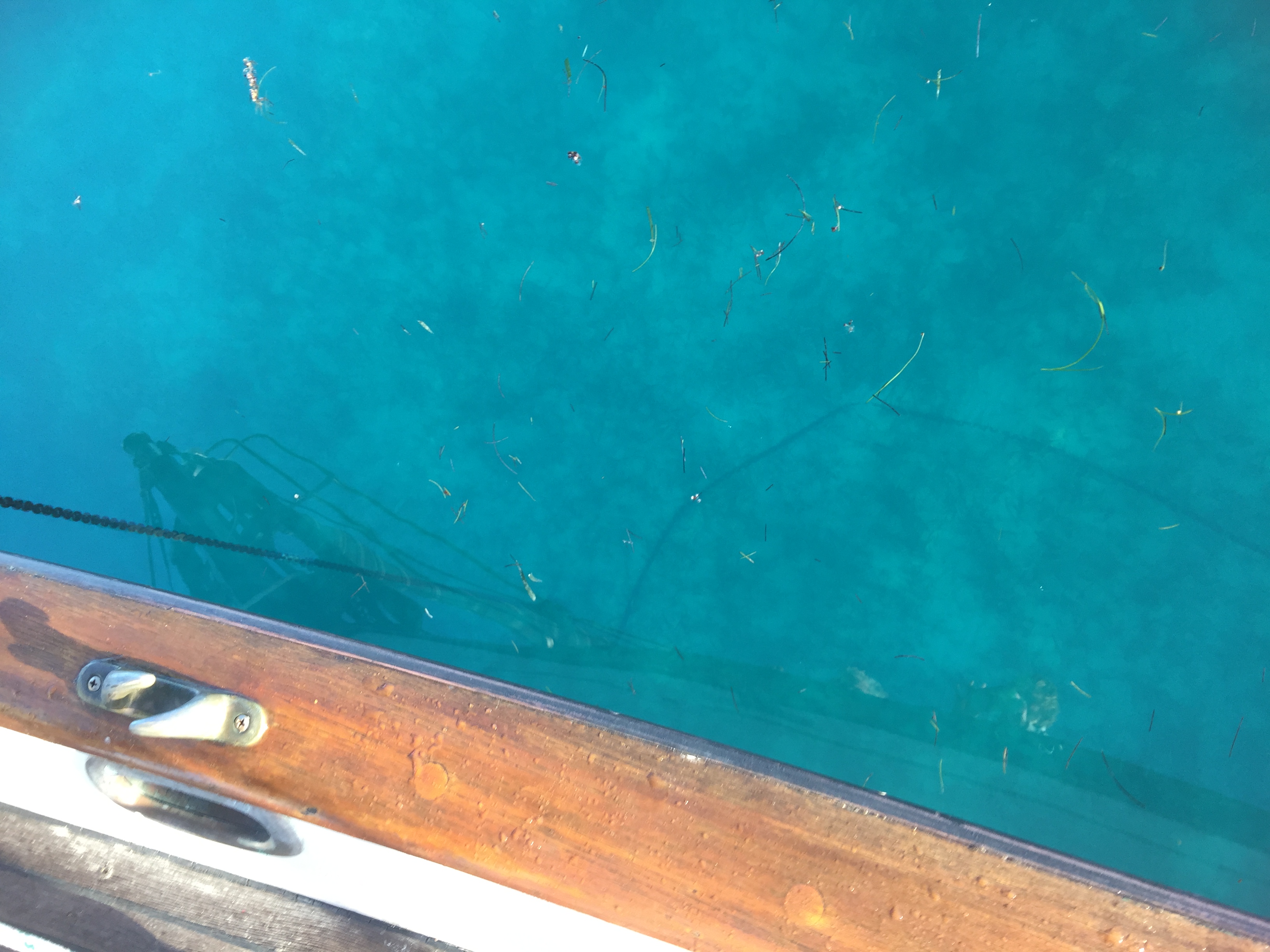
Listening to the high frequency radio weather broadcast of Chris Parker and studying our XM satellite radio weather, we determined that the weather would begin to turn more pleasant on Monday evening and into Tuesday. We decided to sail to Spanish Cay, our next stop, on Tuesday 31 January, anchoring there for the night and then on to Green Turtle Cay for rest, “touristing”, and replenishing on 1 Feb.
On 31 Jan, we sailed on a pleasant northeast wind with a group of dolphins playing with us for a while. (See Elena’s Facebook page for videos) We did not quite make Spanish Cay and anchored off Allans-Pensacola Cay.
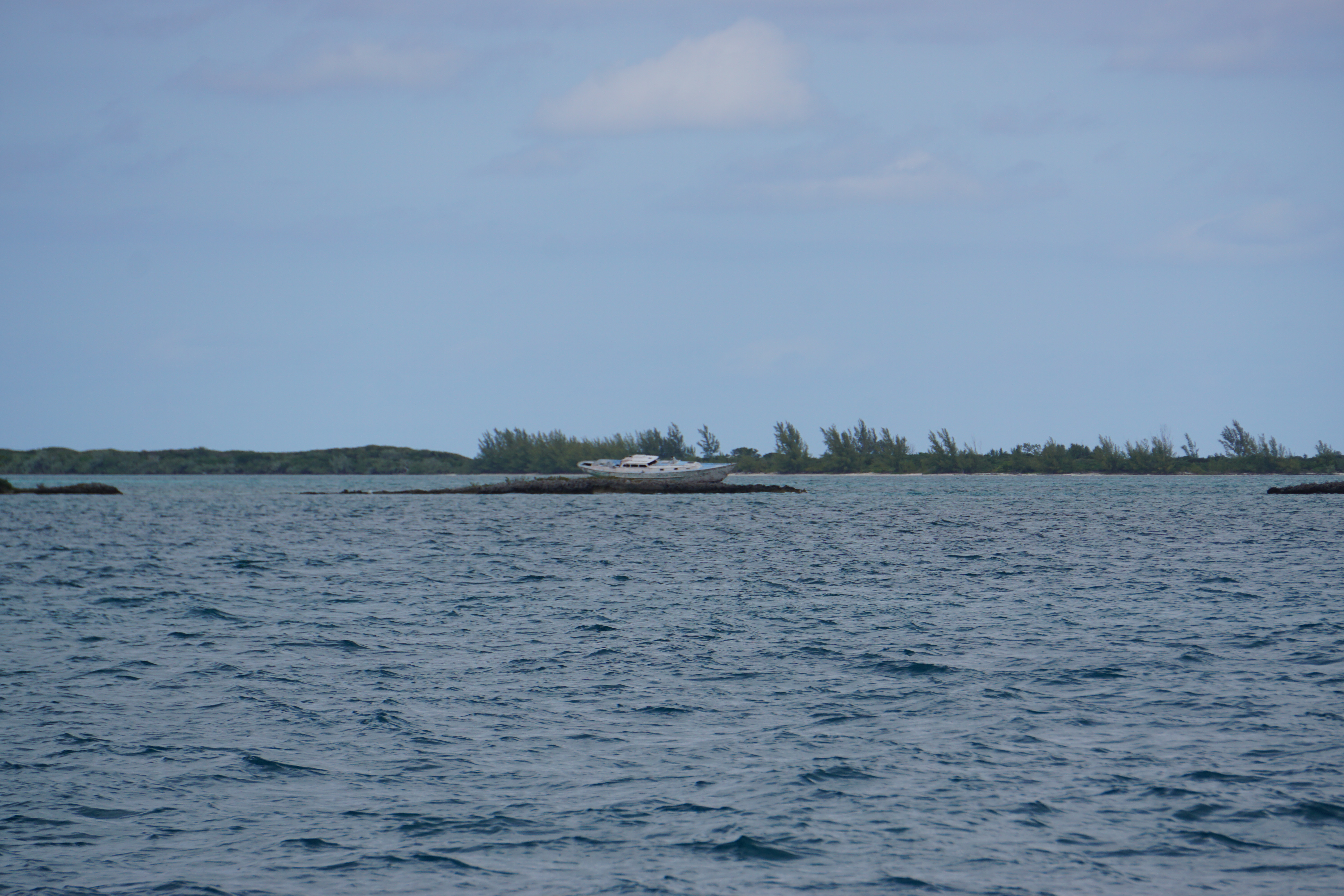
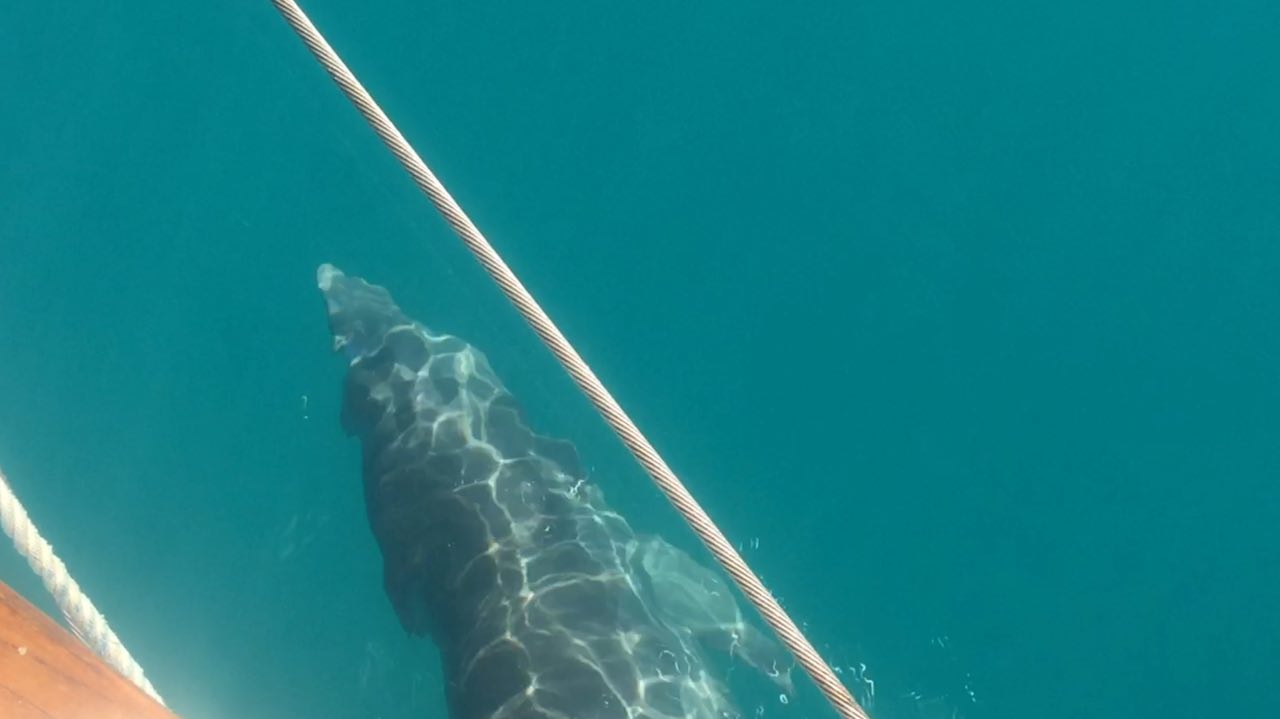
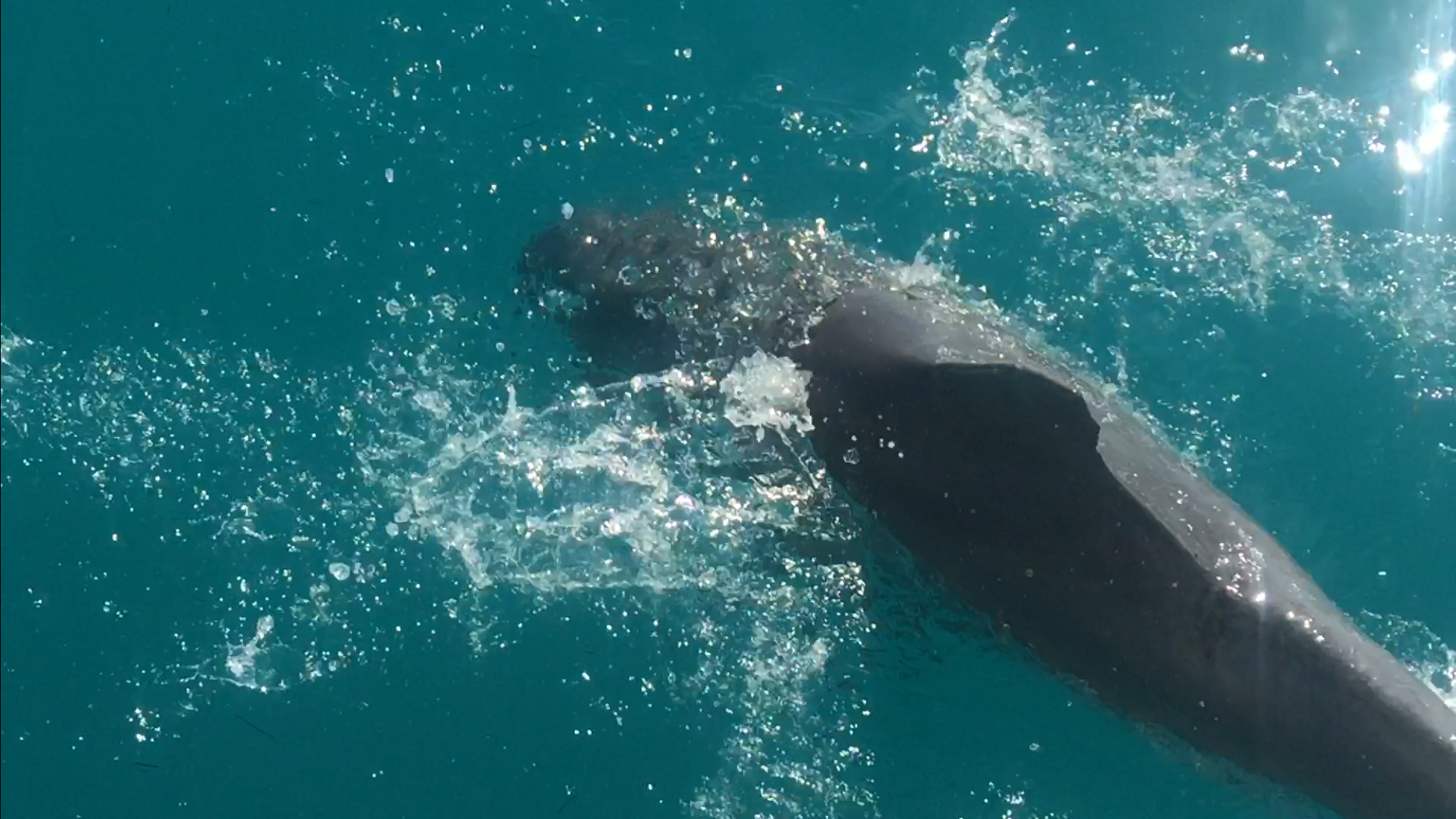
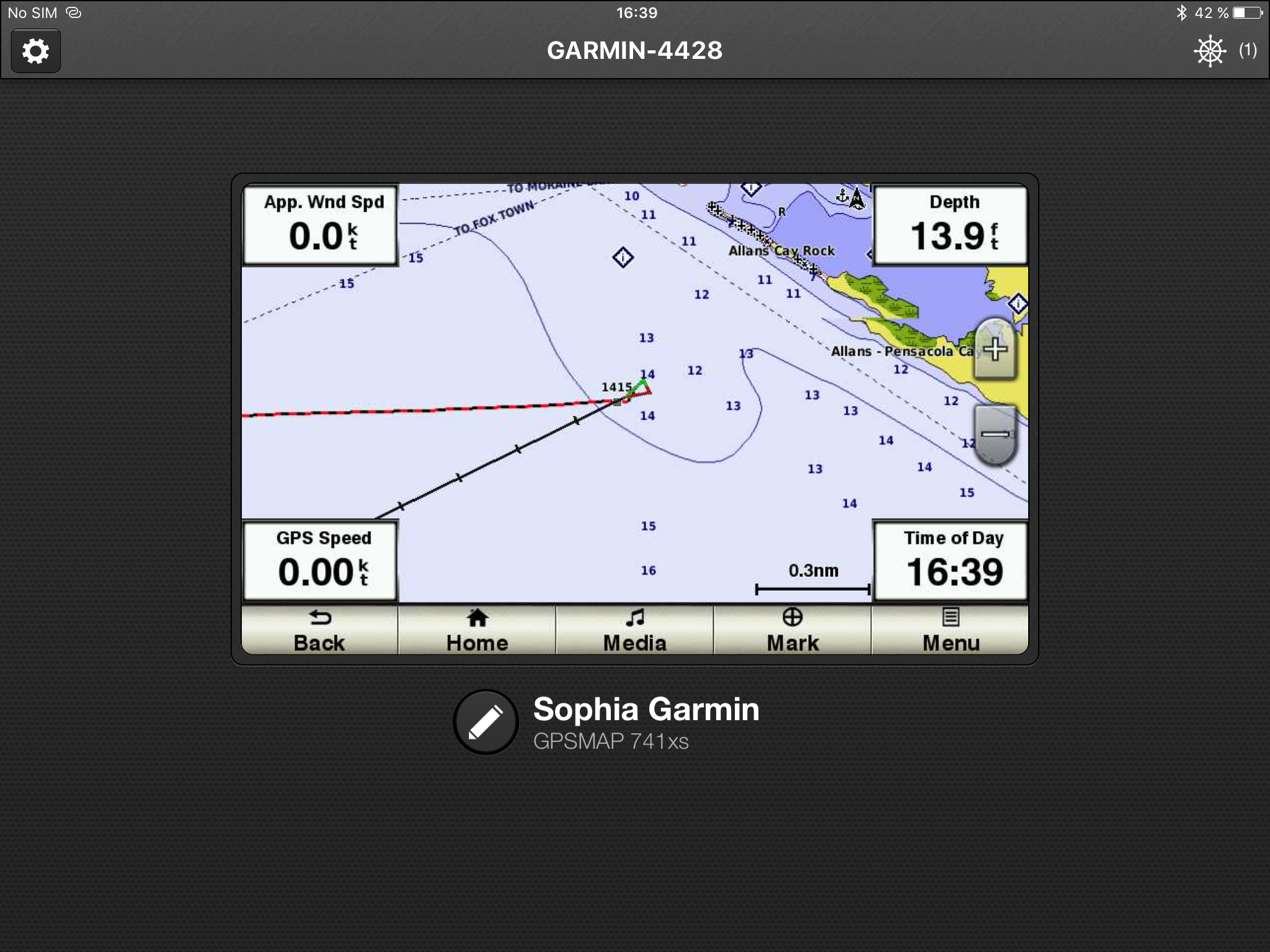
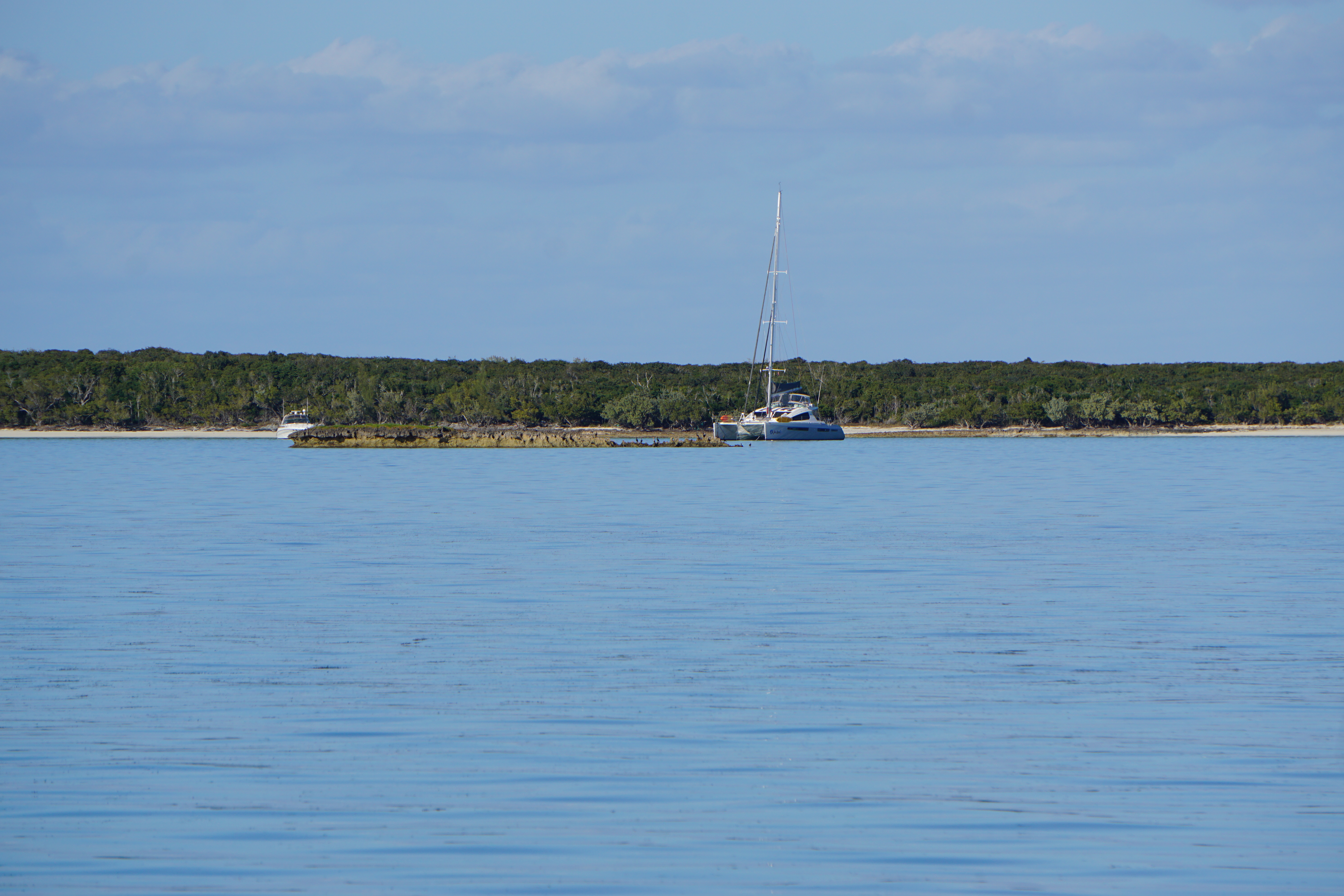
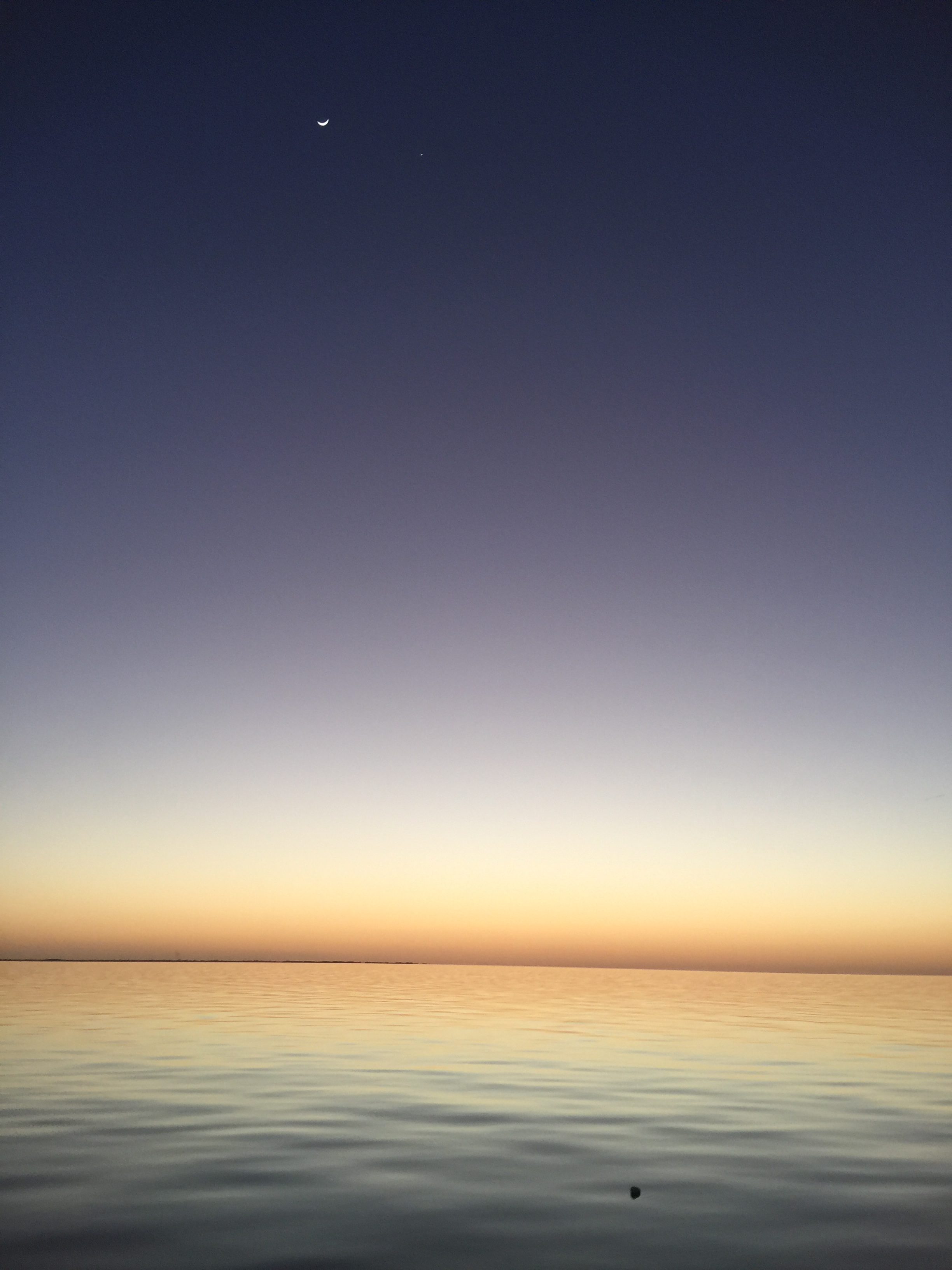
There were 5 boats in the little bay (we were anchored offshore due to Sophia’s deep draft). Our friends Kaiulani came in late in the evening, having sailed several days after us from West End through a very shallow channel of Indian Island Cut, In the morning, we raised sails, pulled up the anchor without even starting the engine, and sailed for Green Turtle Cay, about 20 miles down the Sea of Abaco, closed hauled with main and stay sails on winds from the northeast at 10-12 knots. We tacked once across a narrow portion of the Sea of Abaco to round Crab Cay. The wind slackened a bit and, wanting to arrive before dark, we put out our big genoa sail. (The genoa is one of two sails we have forward of the mast, the other being the staysail). Before we knew it, we were making 6-7 knots and heeled over at 20 degrees, and for us flying down our track to Green Turtle. We anchored about a mile offshore of Green Turtle at 4pm, well before dark.
The seas were calm when we anchored and we could clearly see the bottom in 10 feet of water. We attempted a pre-dinner swim, but the water was too cold (65 degrees) even for Elena in her long swimming pants and top.
The next day we went dinghy ashore for groceries (victuals) and a bit of touristing.




While dinghying through the inside anchorage (Black Sound), we ran into this boat whose homeport is Lafayette, Louisiana, that I thought by Louisiana relatives might find amusing. No one was on board. But nearby was Kaiulani at a marina and we talked briefly with Lynn and agreed to meet ashore.
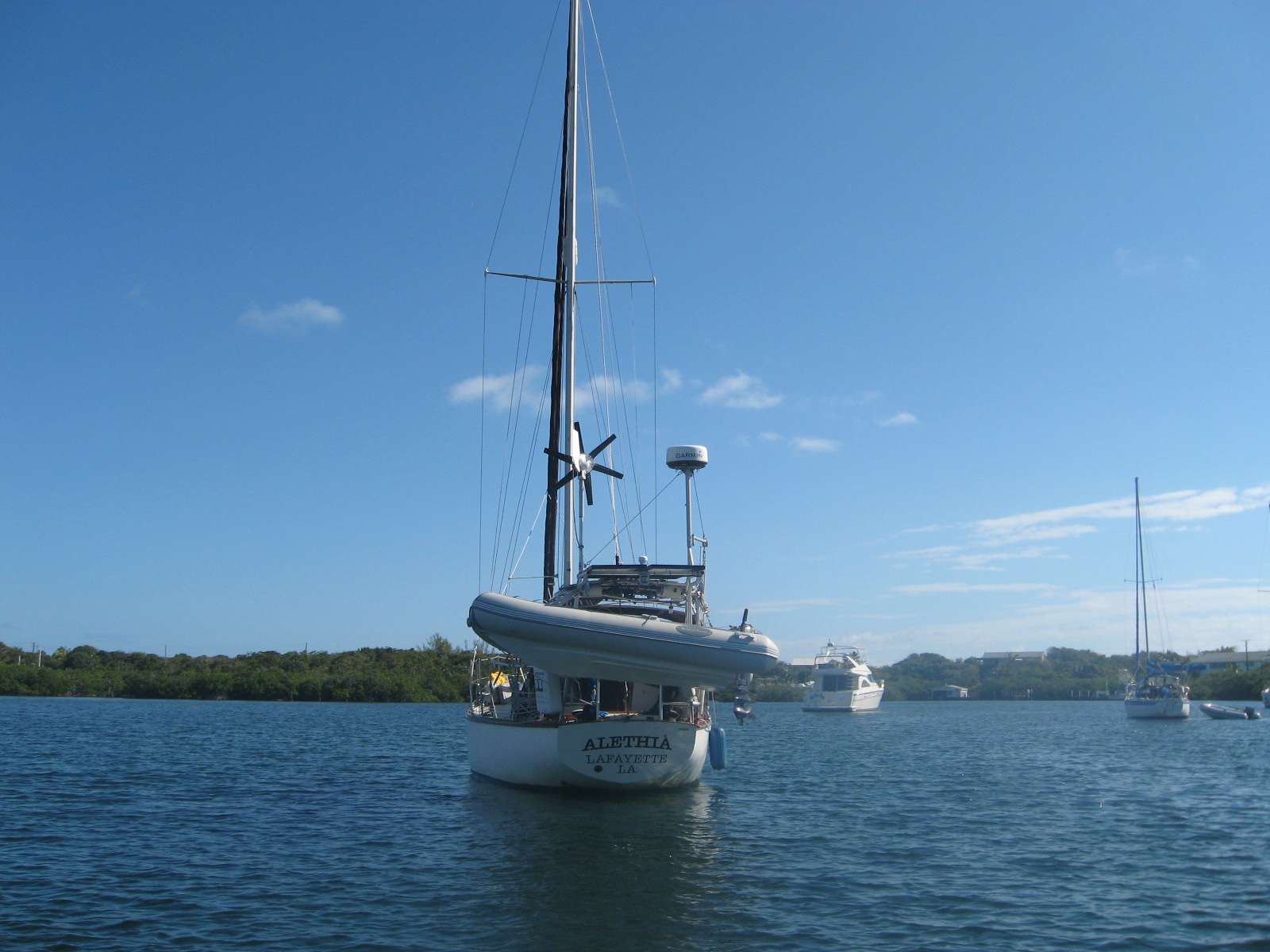
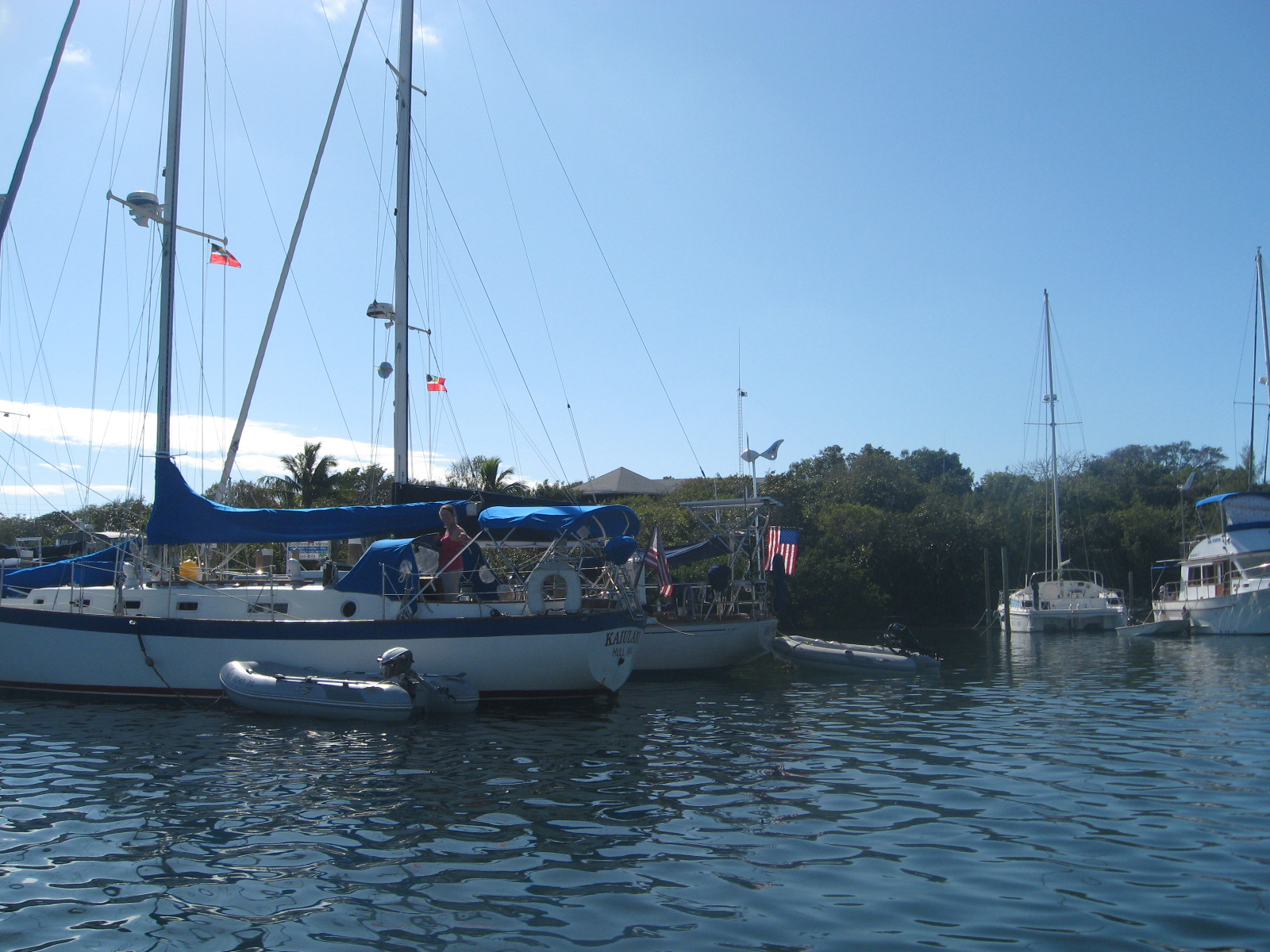
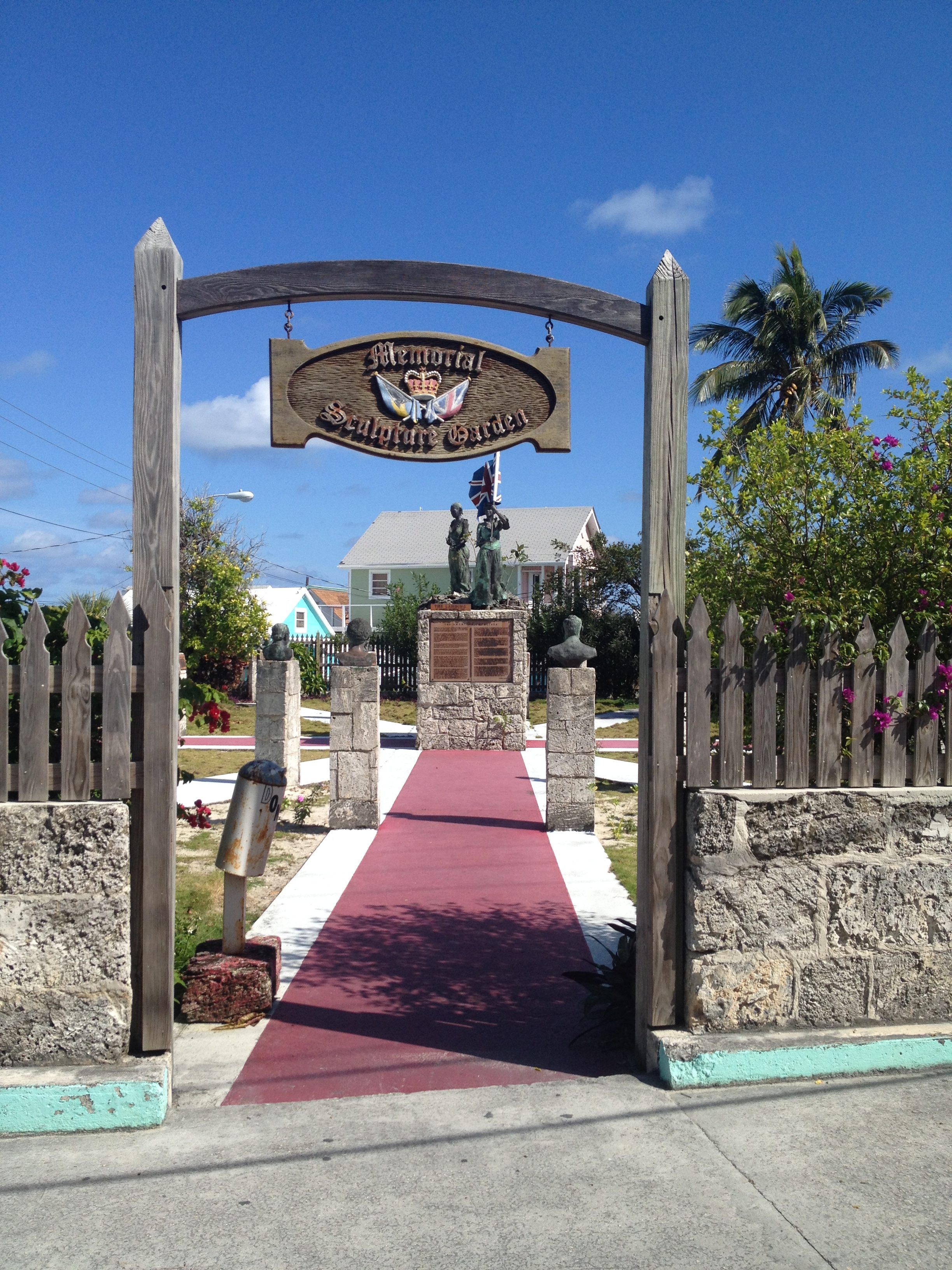

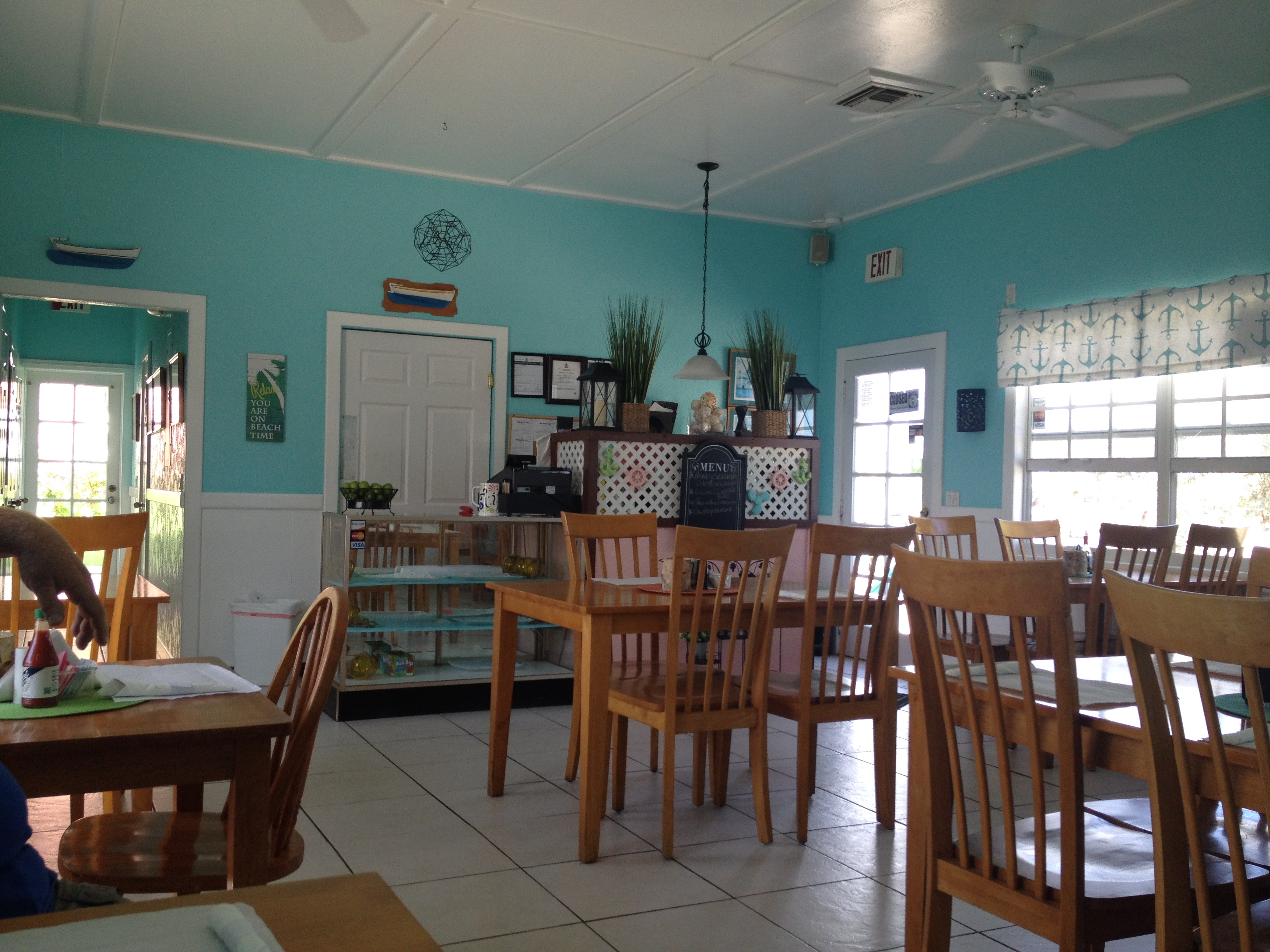

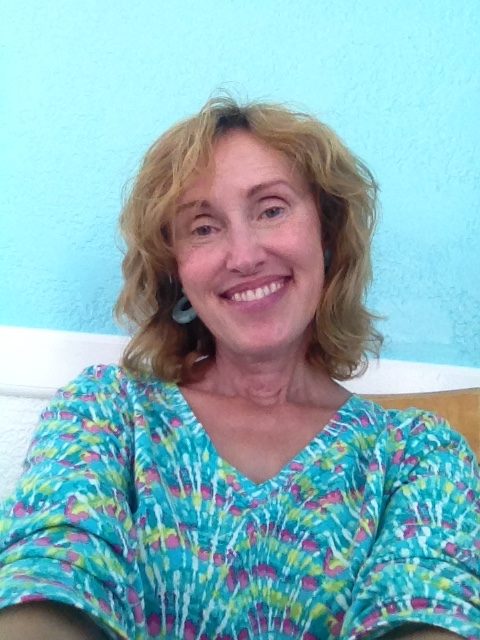
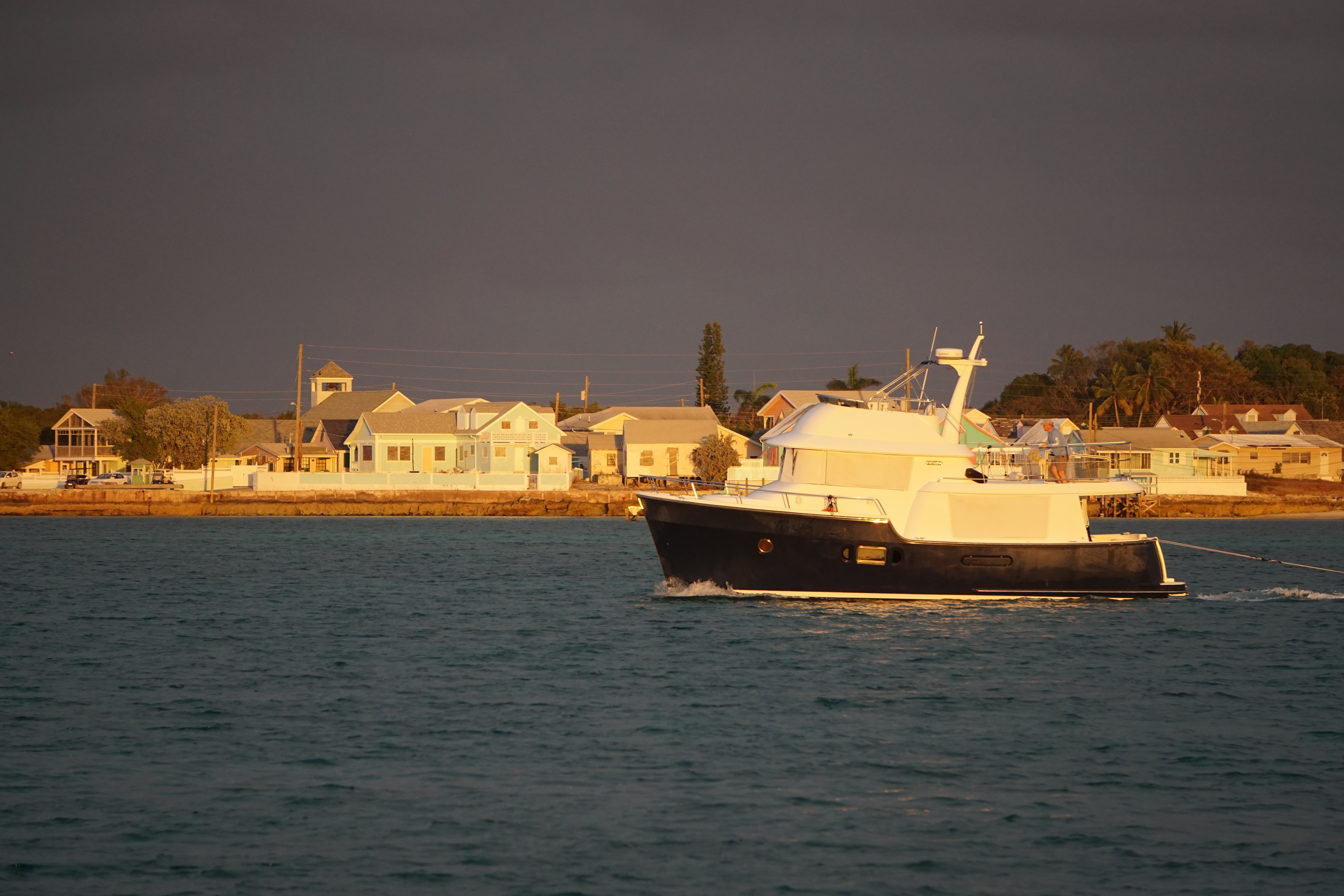
After we tied off the dinghy at a very convenient dinghy dock, Elena immediately found the liquor story (her instincts and priorities are top notch.) We had a lunch of conch and lobster at a small, but nice restaurant. There was a small, quaint grocery store with all the necessities (bread, fresh milk, cookies). After getting the groceries back to the boat, we did laundry at one of the marinas, walked to the beach on the Atlantic Ocean side of the island (Elena was impressed with the shapes of blue), and toured the other anchorage (White Sound) in the dinghy for future reference.
On Saturday 4 February, we went ashore again for another victual run. After returning from the grocery run, we decided to go on to No-Name Cay for the afternoon, proceed to Treasure Cay on Sunday.
Impressions of Green Turtle Cay: Very nice–clean, colorful, convenient–small and quaint. Good place to hold up in a storm or for a long stay as a base to sail to nearby islands. Not typically Bahamian (much more upscale than other “out” islands.)
At 2pm, we weighed anchor with the dinghy in tow for the hour of motoring to No Name.
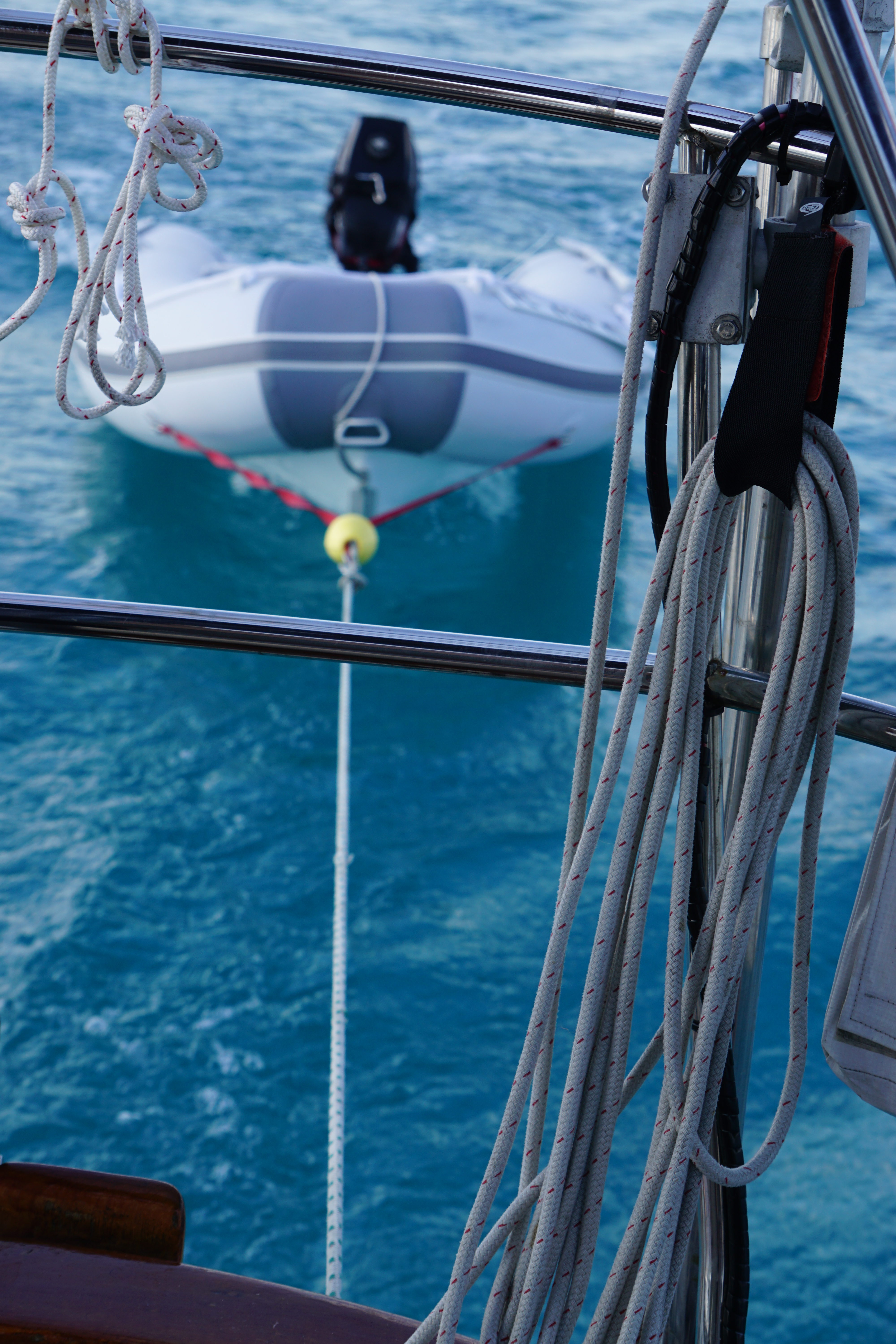
We put out the genoa to help us along and were soon making 5 knots. I let out the tow line to let the dinghy ride easier. We brought the genoa in and turned for the last half mile to our anchorage. We anchored close to shore in 8 feet of water (we draw 6 feet, so a bit on the close side). As we backed down to test the set of the anchor, with me on the bow watching the anchor and Elena at the wheel, Elena lets out a primordial scream. I look around to see the dinghy nose down under the Sophia’s stern, hanging in mid-air at a 45 degree angle, the outboard high in the air. I shouted to Elena, “Kill the engine, kill the engine”. We had backed over the extended tow line and wrapped it around the propeller shaft. Elena stopped the engine but not before the prop cut the web bridle and the dinghy started to float away.
I stripped off my shoes and shirt, and jumped in the water (fortunately it had warmed quite a bit). The dinghy was about 60 feet away and I swam to retrieve it, not really sure how I was going to make it back. Half way there, I reached for my wallet and discovered it missing, with the fleeting thought that maybe I had put it in the navigation station desk, but knowing that I had not. As I reached the boat, Elena shouts, “your wallet, your wallet” and attempts to retrieve it with a fishing net we have for just such a purpose, but it floated out of her reach. I instructed her to launch the manoverboard lifesling in case I could pull the dinghy back. By the time she had the sling out, she had lost sight of the wallet, floating somewhere downwind away from the boat.
I managed to tow the dinghy back to Sophia. Elena lowered our boarding ladder so I could climb into the dinghy. As I started the dinghy engine to search for the wayward wallet, Elena searched for the wallet with binoculars. Using her seamanship skills, she followed the line attached to the lifesling floating astern directly downwind. Lo and behold, she spotted a tiny black speck in a dark blue patch of water. I ran the dinghy over and snatched it up.
Now we had to assess the condition of the prop. We broke out the diving mask and snorkel and after a couple of dives where I tried to use the snorkel underwater (not smart), I got the hang of the diving pulling myself with a line down to the prop. I managed to cut the webbing and some of the line away (about 80%), but a small amount remained jammed in a tight area between the shaft sleeve and the zinc and another between the zinc and the propeller. I tried to remove the zinc but was only partially successful. There is a rubber bearing right at that spot and I worried whether the water passages used for lubrication were blocked by the line. Otherwise, I thought we could use the engine.
There are few pictures of this incident as we were a bit busy for photography.
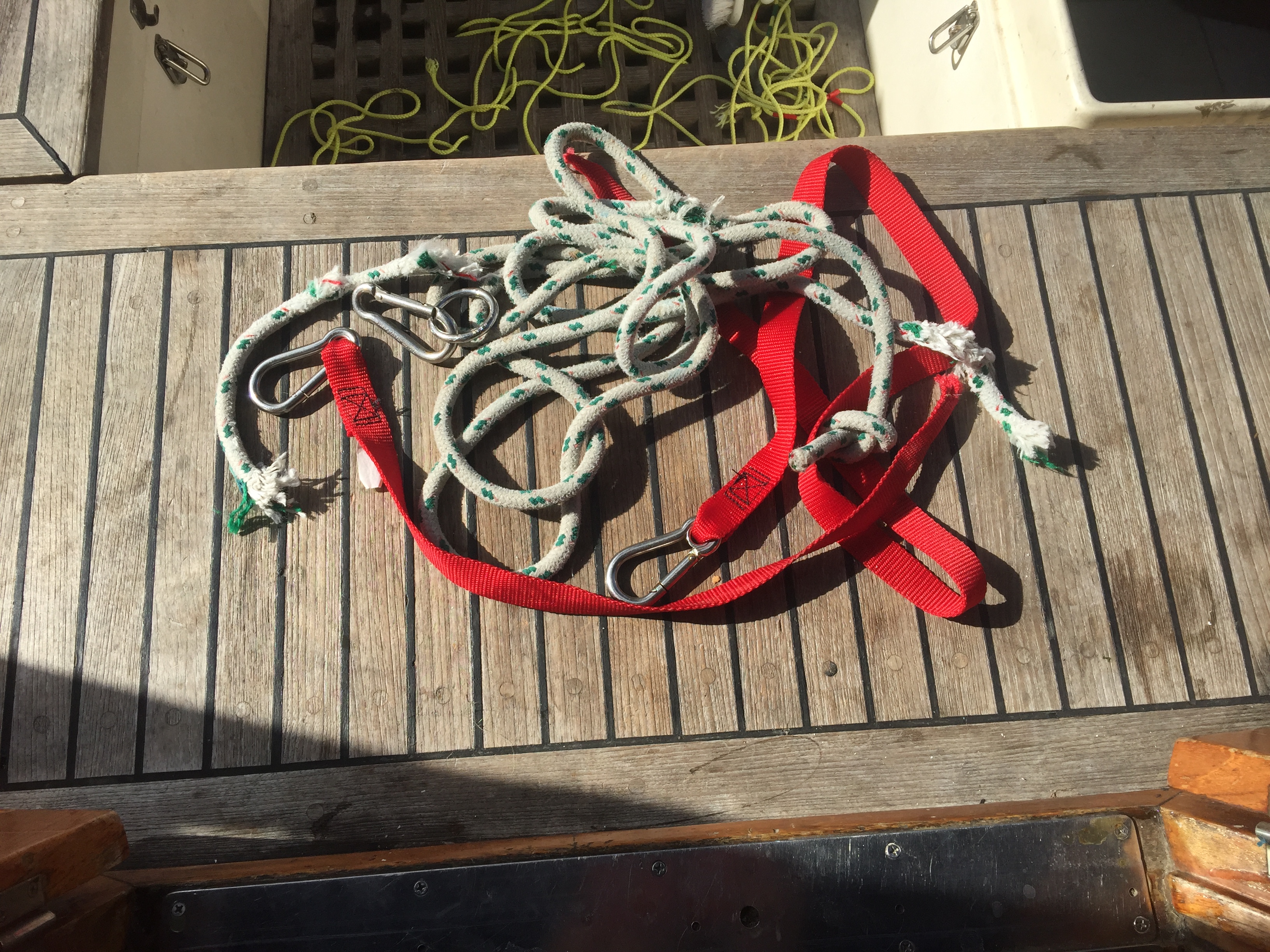
It was getting late and growing dark and I was getting tired and cold. So we decided to call it a day and try again tomorrow. As I was getting out of the water, I noticed a menacing cloud to the northwest and then saw a waterspout in the same area. We put out another 40 feet of chain, in case we saw more wind. And, we did see more wind, 20 knots all night long. In most cases, that is not all that much for us, but we were closer to the beach and in shallow water. Despite being tired from 2 hours of swimming, I spent a sleepless night.
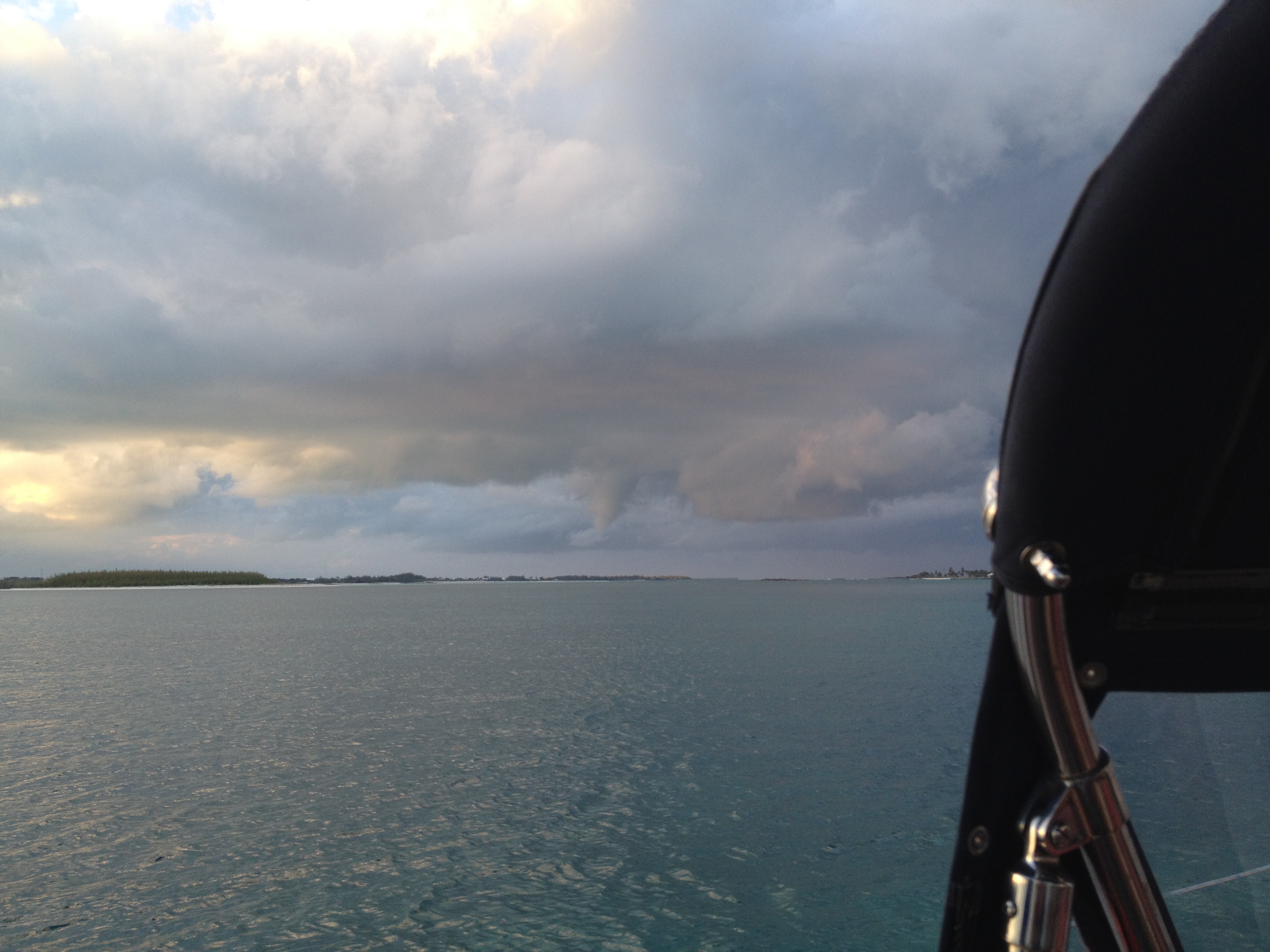
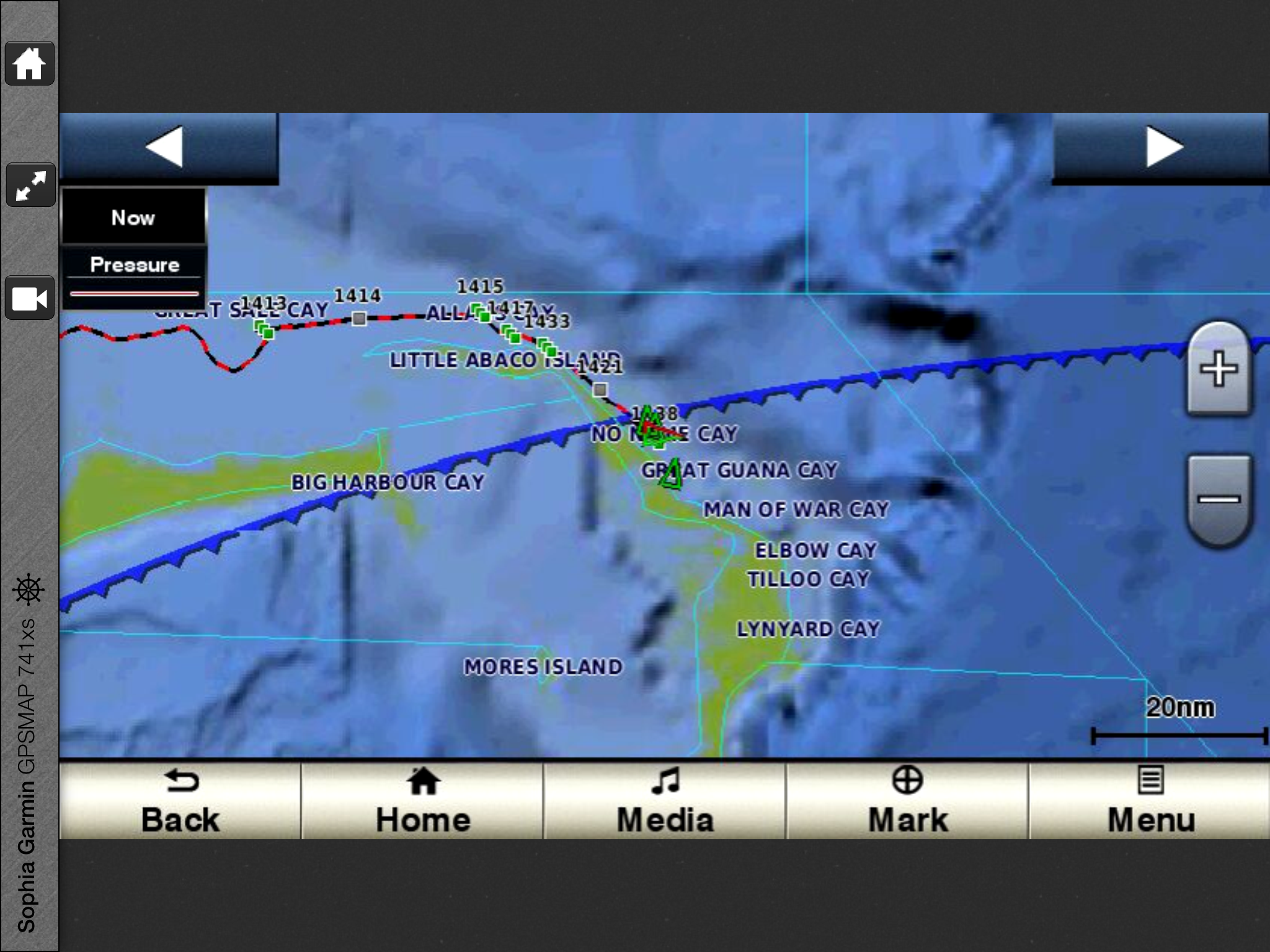
The next morning, I dived again on the prop. I tried to cut the jammed lines and tried to unbolt the zinc. Neither were very successful and it would take a long time to finish this job. I could get down there, but it was a lot of effort to stay down more than a few seconds. After a couple of hours of diving down repeatedly with little progress, we decided to ask for some professional help, calling a dive center (who answered the phone on a Sunday, but said they don’t do that kind of work) and a local yacht yard (no answer). We knew that Rob of Kaiulani had dive tanks and we called him to see if he could help, knowing, that being from Boston, he was not going to miss the Super Bowl. He was willing to help on Monday, but checked with the marina they were staying at and found they routinely provided diving services, but not on a weekend. Rob agreed to work with the marina on Monday to arrange some help.
We did go feed the pigs, which was our original intent. Elena had fun, which helped relieve the stress.
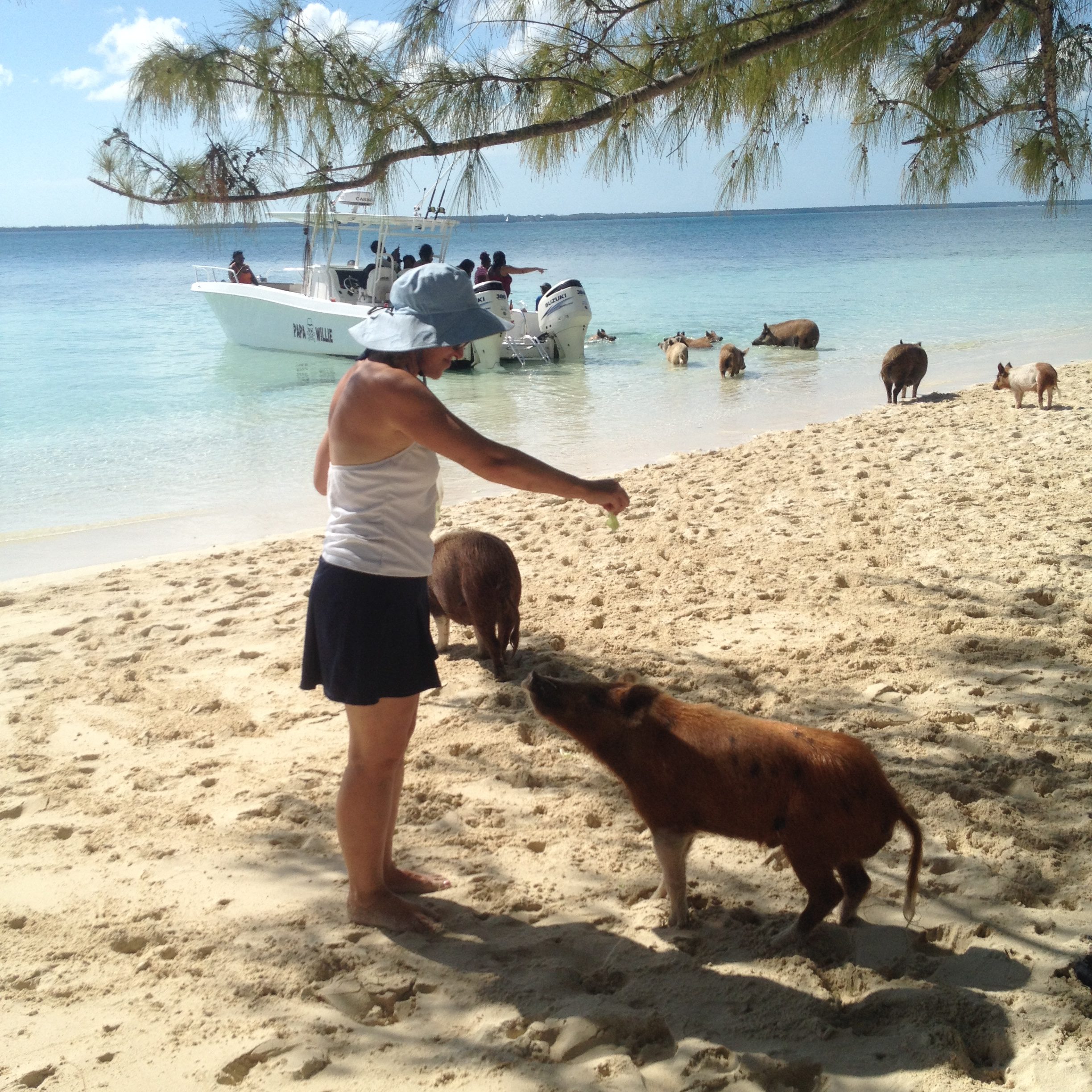
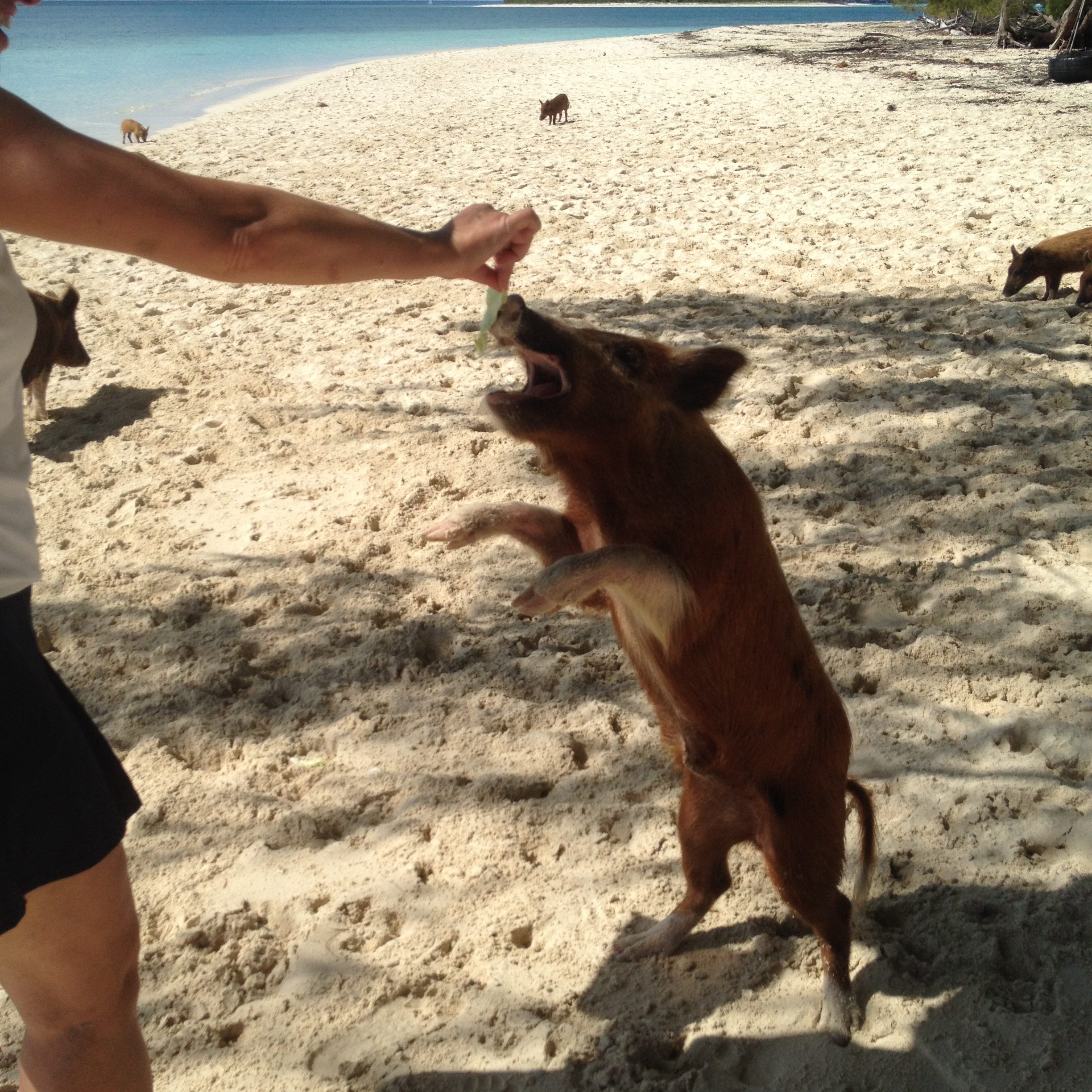

We are now sitting here on Monday morning. The weather window will close on us Thursday when a cold front comes through the area with winds out of the North at 20+ knots and gusts to thirty. We need to be in a safe anchorage or in a marina when that front comes through. Marsh Harbor, our destination for this part of our cruise is not far, about 25 miles away, but we need an engine to get there. There is a leg enroute to Marsh Harbor, that takes us into the Atlantic through narrow waters (called Whale Cay cut) that we need both engine and good weather for to make the transit.
Monday afternoon Rob and Lynn came over with Renaldo from the marina they are staying at. While Lynn and Elena went to visit the pigs, Rob and I watch Renaldo dive (without tanks, tough guy) on the prop. He cleared the line in about an hour and we tested the engine. Best 130 dollars I have ever spent. We did not destroy our brand new (and irreplaceable here) dinghy with the prop nor did it go sailing across the horizon on the Sea of Abacos or out into the Atlantic. And I neither drowned nor had a heart attack. All in all, if the engine is OK tomorrow, we’ll call it a good couple of days with a little experience earned the hard way.
We will be on our way to Marsh Harbor tomorrow via Whale and Treasure Cays.

Nice story. Glad you had a happy end … before the next story begins.
Lena looks great. Pigs are very funny. Keep posting pictures.
Awesome post. I’m really enjoying following you. Looking forward to seeing you guys again. Be safe!